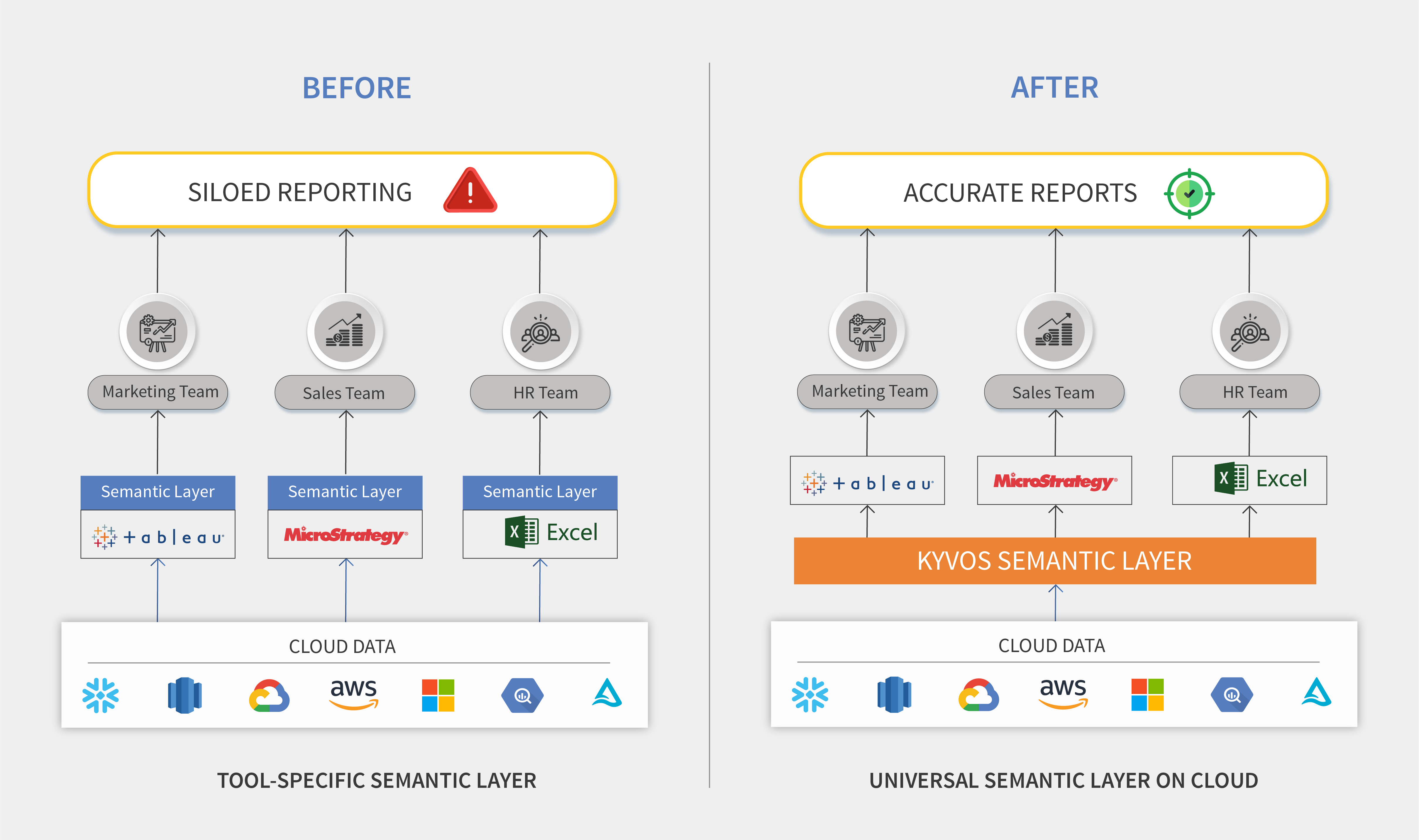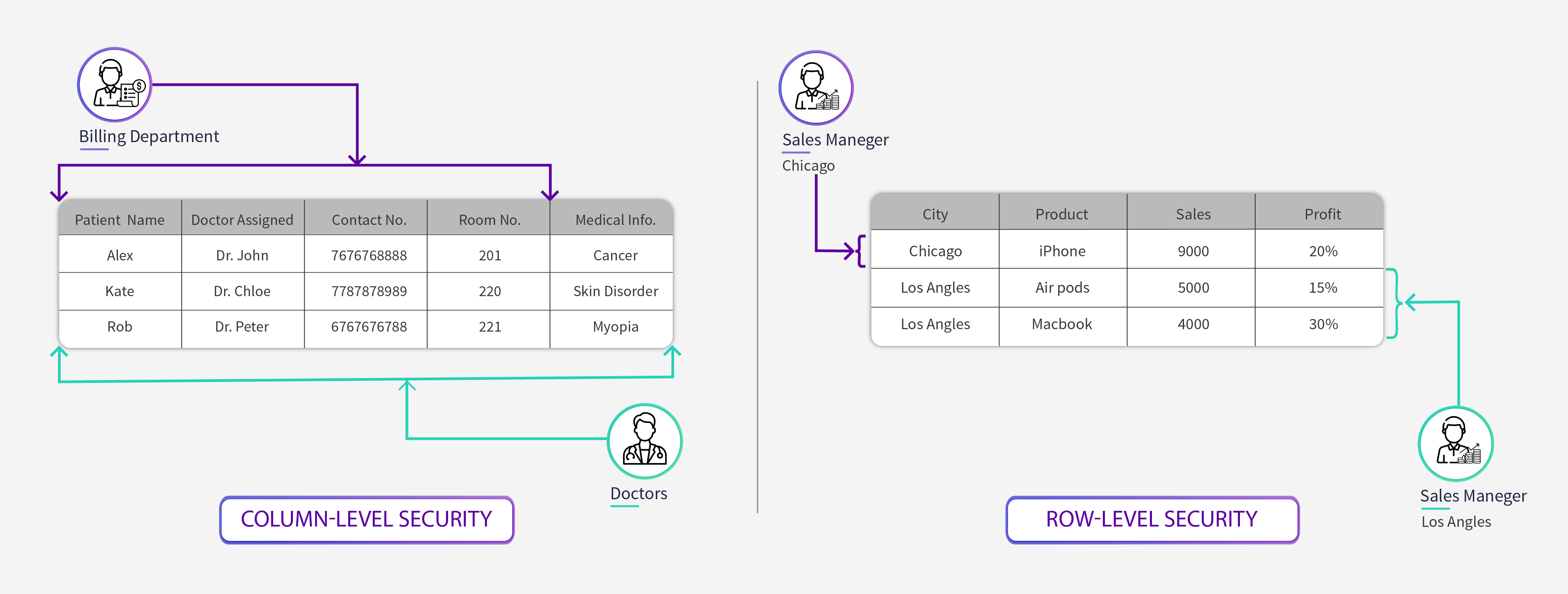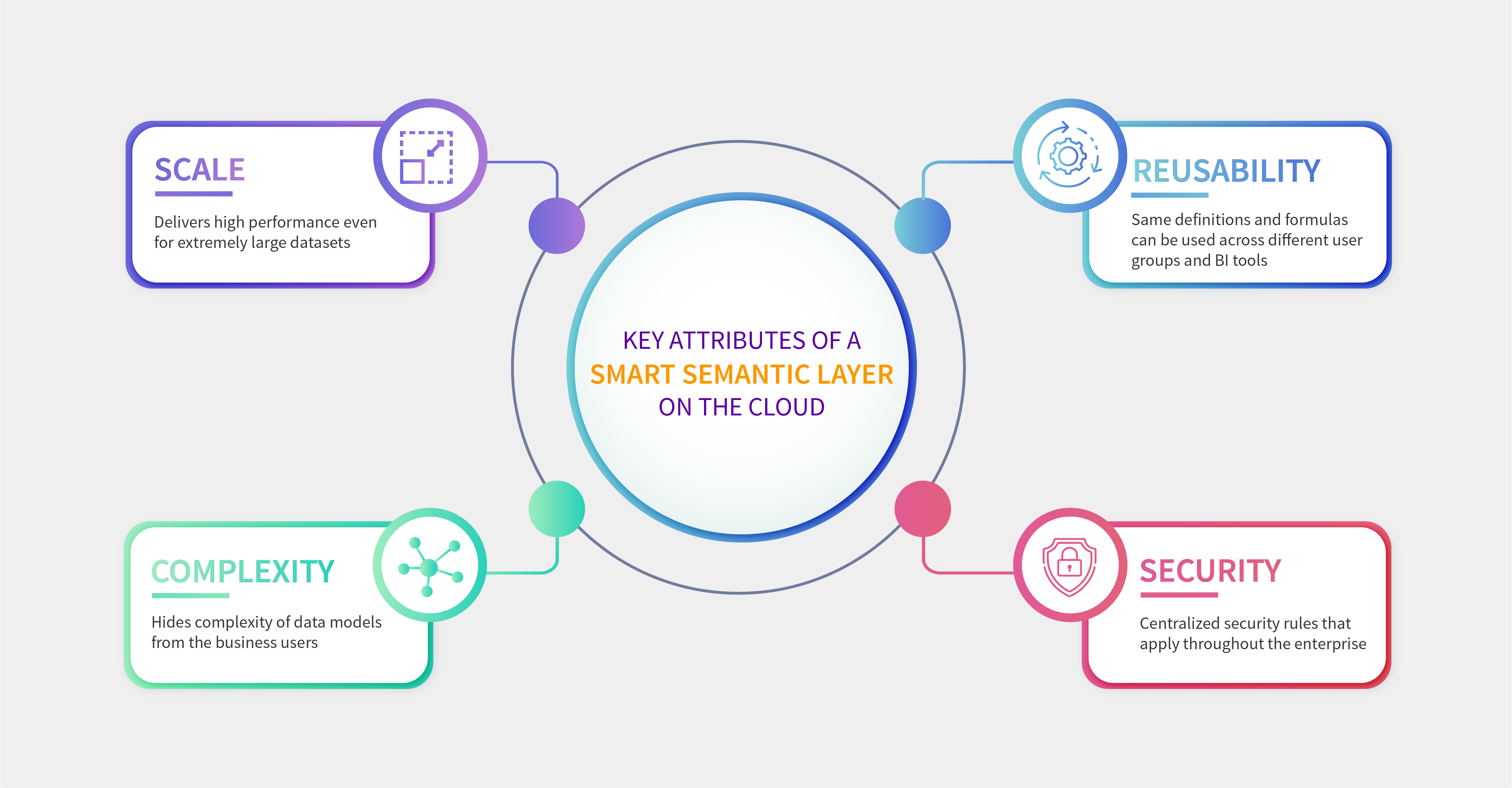With the data increasing exponentially, organizations often find it challenging to get a unified view that spans across the entire enterprise. When users look for the information they need, they are stuck in the disparity of business logic stored across different tools. Simply migrating data to cloud storage or a cloud data warehouse does not solve this problem. As data volumes explode further, this problem becomes more and more evident. Data analysts and engineers face challenges in managing siloed business logic and the associated data access rules.
Industry trends show that as the cloud market matures, businesses will start spending more on cloud services. As per a recent survey conducted by Gartner 70% of organizations are planning to increase their spending on cloud services due to the disturbances caused by COVID-19. In this post, we will cover why now is the time to consider building a Smart semantic layer on cloud that can act as a central governance gateway across your enterprise.
“The semantic layer on cloud acts as a modern layer of business abstraction that provides a comprehensive view of data by uniformly maintaining business metrics, data access rules, calculation logic, etc., in one place. This way, business users no longer have to worry about the technical complexity of the data source. “
Battle of Business Users with Siloed Reporting
The semantic layer is not a new terminology for us; it’s been in the picture since the early 90s. It was invented to mold the SQL dialects of relational databases into an easily understandable interface for business users. Until recently, every business intelligence platform had its unified semantic layer tightly coupled.
Everything was going well for enterprises as long as they stayed within the wall of restricted access of the BI platform vendor of their choice. However, as the volume of data on the cloud is increasing, it’s becoming more challenging for data scientists and BI users to inflict a single standard for consuming and driving analytics. As a result, large organizations opt for more than one BI tool, making the situation more dreadful, as each business unit or group prefers having their own version of the truth. Due to this reason, they end up creating inconsistent reports and siloed analysis – both outcomes can lead to severe implications for business. So, businesses need to work on consistent, unified data because insufficient data or poor reporting can cost them enormously. According to research conducted by Gartner, “On an average, organizations had to bear a loss of $9.7 million per year as a consequence of sample data reporting.
It’s time to adopt a Smart semantic layer approach to cater to your present and future needs of data volume, velocity, and variety. A semantic layer defines business metrics, data access, and transformations in one place for analytics consumers. This way, all users will more likely generate accurate reports, regardless of their use case or toolsets.
Welcome to the World where you can Achieve a Single Source of Truth!
Achieving a single source of truth is as essential for businesses as gasoline to a car.
Like fuel powers cars to run while maximizing efficiency and minimizing engine damage, the same is the work of a semantic layer on the cloud to enhance productivity and deliver the best value for enterprises.
A semantic layer on the cloud bridges the gap between business users and complex data sources by adding business knowledge right on top of the data layer. For instance, a leading supply chain business had to deal with the advent of massive amounts of data accumulated from different data resources. But what’s its use if it can’t be used to get deeper and richer insights that can help optimize supply-chain management? When asked about the challenges faced by the organization with existing systems, they said:
- They could not get a unified view of 100+ years of our data stored across multiple applications
- The performance and speed of their analysis tools were deteriorating with time due to large volumes of data and query limitations.
- Creating reports from billions of rows of data seemed impossible, so they had to create partial reports on less data, which resulted in inaccurate results.
- Lack of a scalable architecture.
- They were unable to drill down to granular details.
Supply chain leaders needed an environment that could offer high-performance and quick analytics irrespective of how extensive and complicated their supply chain data was. Kyvos helped them overcome these challenges by centralizing and standardizing their data logic. It created a universal semantic layer on their data source platform, helping them access a single source of truth with full confidence in its integrity. With the help of Kyvos, they could analyze two years of historical data with super-fast response times.

Figure 1: A Universal Semantic Layer on the cloud eliminates the challenges of siloed reporting and helps achieve a single source of truth across the enterprise
So, for enterprises to achieve a single source of truth, it’s essential to add a semantic layer in their cloud BI architecture to resolve data complexity and volume issues while empowering business users to get a consistent view of all enterprise data.
Why you need a Smart Semantic Layer on the Cloud?
In this era, when data is everywhere, it’s essential to enforce rules to prevent your data from unauthorized data access, even from the people who are inside the firewall. Instead of managing a security layer on various entry levels, wouldn’t it be easy to have just one layer that can provide secure access to your data, whether it’s on cloud storage or a cloud data warehouse? Kyvos universal semantic layer on the cloud acts as a front door for every analytical query fired irrespective of who is firing that query.
Kyvos provides a native three-tiered security architecture that works seamlessly with cloud platforms and ensures data protection at multiple levels. Since the semantic layer is in between the organization’s data storage system and analytics tool, it enables granular-level semantic data platform access control through row and column level security at the group and user levels. Let’s see how this helps:
- Column level security enables you to hide specific dimensions or measures from a group of users. For example, hospitals would not want to share the sensitive medical information of their patients with their billing department. So, in this case, it’s important to implement some rules broadly and consistently to prevent unwanted data access and sharing. With Kyvos semantic layer on the cloud, you can explicitly define a centralized set of rules that will apply to a group of users. Whenever any query knocks on the door of the semantic layer on the cloud, it will screen and filter all the data fields and extract results in accordance with the rules defined.
- Row-level security enables you to hide specific rows. It is applied when you want a particular group to access information that is only relevant to their group. For example, The sales team of city Chicago will not have access to the sales data of Log Angeles, because the sales data of Los Angeles is not relevant for the Chicago team here.

Figure 2: A Smart Semantic Layer enables granular-level data access control through row and column level security
Performance + Scale: Free yourself from the Worries of Future Data Workloads
In the future, the number of data sources and data complexity will further rise, so you need a solution that can not only deal with current requirements but also cater to future needs. Kyvos semantic layer is designed to scale and deal with massive data workloads. Powered by Smart OLAP™ technology, Kyvos can handle scaling and complexity issues of your data. The semantic model hides the physical complexity of data from business users while OLAP capabilities deliver exceptionally high performance. This means you don’t have to worry about future data workloads, and you can focus more on reporting and analysis.
Data and analytics play crucial roles in helping you make more confident and accurate decisions. The correct infrastructure deployment empowers your teams to trust the data they have, apply it to their use cases in logically consistent ways, and maintain proper data security and governance. A semantic layer also future proofs your data against new data storage and consumer technologies while improving data query speed and performance.

Figure 3: Key attributes of a Smart Semantic Layer built natively for the cloud
Simplify your Analytics Stack with a Smart Semantic layer on the Cloud
Data for businesses is like an asset. It plays a crucial role in making intelligent and accurate business decisions. If businesses have a conventional infrastructure, it empowers business users, data engineers, and data analysts to use this data logically for their use cases without worrying about data security and governance issues.
Instead of lingering within the walled gardens of your tool-specific semantic layer, why not add a universal semantic layer on the cloud. Don’t think of it as the extension of one more layer in your architecture; think of it as a solution that can simplify your architecture.
If you want to learn more about how Kyvos can help you to build a semantic layer on the cloud, request a demo now.
FAQ
What is a smart semantic layer, and how does it work on the cloud?
A smart semantic layer is an abstraction layer providing a consistent and unified way of interpreting enterprise data. It maps complex data into familiar and simplified terms so that users across the enterprise can access the same source of truth with full confidence in its integrity. This layer on the cloud bridges the gap between business users and complex data sources by adding business logic on top of the data layer.
How does a smart semantic layer enhance data governance and data quality in the cloud?
Instead of managing a security layer on various entry levels or BI tools, Kyvos Smart Semantic Layer can provide secure access to your data, whether on cloud storage or a cloud data warehouse. A native three-tiered security architecture works seamlessly with cloud platforms, ensuring data protection at multiple levels.
Can a smart semantic layer on the cloud handle real-time data analytics?
In a smart semantic layer, all the combinations are pre-processed, and semantic models deliver fast performance for unlimited queries across hundreds of hierarchies and dimensions. Users can access data analytics in real-time by slicing and dicing ort drilling down the information on the semantic model and get instant responses.
How does a smart semantic layer improve self-service analytics?
A smart semantic cloud layer helps centralize and standardize all business logic on top of the data layer so that every user can speak the same language. It can better control data pipelines by eliminating inconsistencies and creating smart analytics at suitable scales for better and quicker decision-making. In a collaborative environment, every team has a single version of the truth to rely on.
Are there any challenges or considerations when implementing a smart semantic layer on the cloud?
Users face no difficulties or challenges when implementing Kyvos’ Smart Semantic Layer™. Our prompt and accurate infrastructure deployment empowers teams to trust their data, apply it to their use cases in logically consistent ways, and maintain proper data security and governance.
